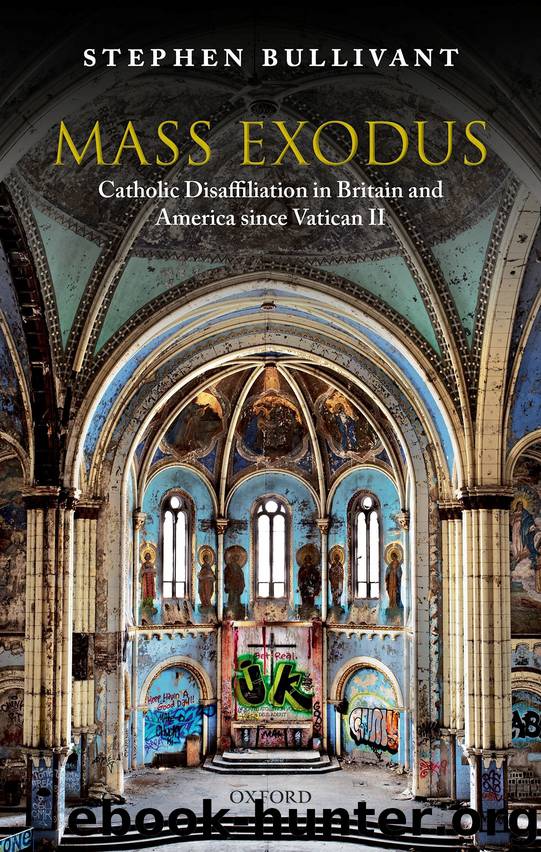Mass Exodus by Stephen Bullivant

Author:Stephen Bullivant
Language: eng
Format: epub
ISBN: 9780192575098
Publisher: OUP Oxford
Published: 2019-03-14T16:00:00+00:00
Choosing One or the Other
The previous chapter dwelt in detail on the rich devotional life of post-war-but-preconciliar Catholic life: popular religiosity in both senses of the term. It was argued, moreover, that these were clear examples of what cognitive anthropologists refer to as Credibility Enhancing Displays (CREDs). Ex hypothesi, the profusion of Catholic devotional CREDs had a mutually galvanizing effect within the communities in which they were practised. (In Chapter 7, we will explore how Credibility Undermining Displays, or ‘CRUDs’—that is to say, revelations of religious figures failing, horrifically, to live up to their professed ideals—can contrarily corrode Catholic identity.)
There is some evidence that the ‘close-knit unity of texture and imaginative hold [ … ] of the pre-Conciliar devotional world’ (Duffy 2004: 24) was already, by the late 1950s, showing the beginnings of decline. This was largely due to the same basic factors detailed in Chapter 4: suburbanization, middle-class-ization, other things to do of an evening, and so on (e.g., Kane 2004). That cracks were developing beneath the shamrock—or in Polish parishes, white eagle—wallpaper does not, however, account for the startlingly swift collapse of the entire edifice, beginning in the mid-1960s. That required an ‘inside job’.
Sacrosanctum Concilium, once again, does not itself mandate any policy of suppression. On the contrary, ‘Popular devotions of the Christian people are to be highly commended’ (SC 13), and ‘The practice of placing sacred images in churches so that they may be venerated by the faithful is to be maintained’ (SC 125). Nevertheless, these affirmations are accompanied by cautionary comments, which imply that Catholic devotionalism, as currently practised, could use some reining in. Hence one gets the impression that sacred images, though fine enough in themselves, are prone to being problematic: ‘Nevertheless, their number should be moderate and their relative positions should reflect right order. For otherwise they may create confusion among the Christian people and foster devotion of doubtful orthodoxy’ (SC 125). Furthermore, the Council’s statement that devotions ‘should be so drawn up that they [ … ] accord with the sacred liturgy, [ … ] and lead the people to it, since, in fact, the liturgy by its very nature far surpasses any of them’ (SC 13) rather suggests that, as things stand, this is far from always the case.
These warnings are consonant with the document’s overriding emphasis on the Mass—especially that of Sunday, the Church’s pre-eminent communal celebration ‘as the foundation and kernel of the whole liturgical year’ (SC 106)—as ‘a sacred action surpassing all others; no other action of the Church can equal its efficacy by the same title and to the same degree’ (SC 7). Nothing, therefore, may be permitted either to detract from this ‘summit toward which the activity of the Church is directed’ and ‘the font from which all her power flows’ (SC 10; cf. Lumen Gentium 11), or to distract ‘the faithful [from taking] part fully aware of what they are doing, actively engaged in the rite, and enriched by its effects’ (SC 11).
For many influenced by the Liturgical Movement, that is precisely what devotional practices did.
Download
This site does not store any files on its server. We only index and link to content provided by other sites. Please contact the content providers to delete copyright contents if any and email us, we'll remove relevant links or contents immediately.
Resisting Happiness by Matthew Kelly(2888)
The Social Psychology of Inequality by Unknown(2312)
Designing Your Life by Bill Burnett(2269)
Day by Elie Wiesel(2243)
The Giving Tree by Shel Silverstein(1839)
Angels of God: The Bible, the Church and the Heavenly Hosts by Mike Aquilina(1628)
Human Design by Chetan Parkyn(1574)
Augustine: Conversions to Confessions by Robin Lane Fox(1474)
The Supreme Gift by Paulo Coelho(1449)
Hostage to the Devil by Malachi Martin(1398)
7 Secrets of Divine Mercy by Vinny Flynn(1394)
Jesus of Nazareth by Joseph Ratzinger(1381)
The Vatican Pimpernel by Brian Fleming(1343)
Dark Mysteries of the Vatican by H. Paul Jeffers(1342)
Saints & Angels by Doreen Virtue(1312)
St. Thomas Aquinas by G. K. Chesterton(1309)
My Daily Catholic Bible, NABRE by Thigpen Edited by Dr. Paul(1210)
Called to Life by Jacques Philippe(1204)
The Ratline by Philippe Sands(1166)
